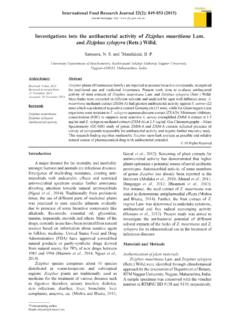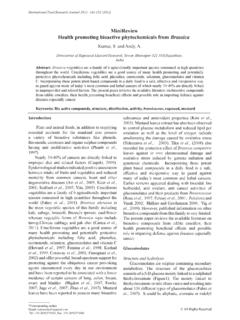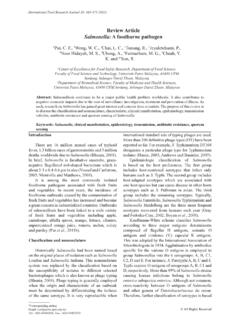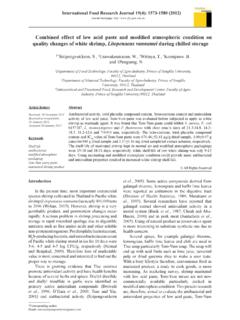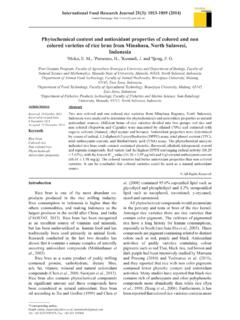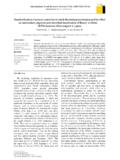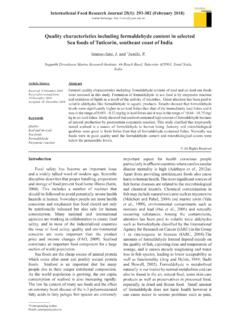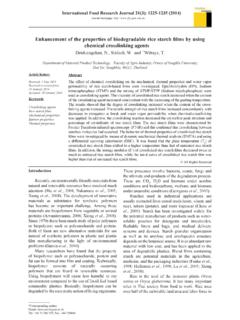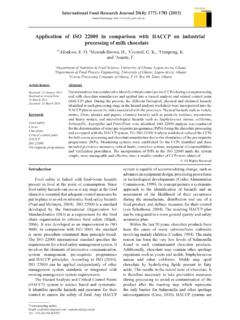Transcription of Incidence of multiple potentially pathogenic …
1 All Rights Reserved*Corresponding author. Email: Tel: +88 028354577 (Ext-472); Fax: +88 02 9143531 International Food Research Journal 21(1): 131-134 (2014)Journal homepage: *Md. Shahidul, K., 1 Mehadee, H. and 2 Sunjukta, of Microbiology, Stamford University Bangladesh, Dhaka, Post code1217, Bangladesh2 Department of Microbiology, Dhaka University, Dhaka, Post code 1000, BangladeshIncidence of multiple potentially pathogenic bacteria in tap water from different restaurants in Dhaka city, BangladeshAbstractThis study was conducted to determine the presence of potentially pathogenic bacteria in 20 tap water sources used in different restaurants in Dhaka city. A questionnaire was used to determine the aesthetic quality and extent of use of these sources.
2 In the microbiological examination, all samples were found to be contaminated with coliforms. Although fecal coliforms could not be detected in samples 5, 12 and 16, these samples were found to be contaminated with coliforms and pathogenic bacteria such as, Vibrio spp., Shigella spp. and Salmonella spp. Concentrations of total heterotrophic bacteria were beyond the recommendation suggested by the World Health Organization ( 104 and 104 cfu/ml). These contaminated waters pose threats to the health of the consumers. It is possible that deep tube well water is cross contaminated from underground sewerage lines which require repair and amendment of water supply system. IntroductionClean and safe water is essential for healthy living though many people do not get clean and safe water for drinking and household use (WHO, 2008).
3 Water-borne diseases are very common in the developing countries and still pose major threats to those who cannot afford clean water. Waterborne diseases like cholera, typhoid fever and bacillary dysentery are reported more frequently during any drinking water associated outbreaks than it was reported before (Fenwick, 2006). According to the World Health Organization (WHO), more than 5 million people die each year due to water related diseases of which more than 50% deaths are due to cholera alone (Fenwick, 2006). Fresh waters and coastal sea water bodies are frequently contaminated with human and animal feces through discharge of untreated wastewater (Grabow, 1996; George, 2001; Fenwick, 2006).
4 Many people in developed countries and children <5 years old in developing countries suffer from water related diseases due to contaminated water supply and poor hygienic conditions (Seas, 2000; Medema, 2003). High Incidence of waterborne diseases is increasingly reported in developing countries like India (Khera, 1996). Spreads of waterborne diseases are often found to be associated with the consumption of contaminated water possibly due to their ignorance, poverty and unavailability of clean water. There are several studies conducted on bottled water, DWASA water and surface water of Bangladesh but there is not enough study on tap water sources especially from restaurants in Dhaka city.
5 In this study we surveyed the level of contamination in the water distribution network of Dhaka Water Supply and Sewerage Authority (DWASA). DWASA draws more than 80% of its water from the underground below Dhaka city and the remaining amount from surface water treatment plants. Materials and MethodsSamplingTwenty tap water samples were collected randomly from different restaurants from Moghbazar and Malibag area of Dhaka City. Specific locations of the sampling sites are shown in Table 1. Samples were collected between March 2011 and May 2012. Samples were collected in sterile 250 ml plastic bottles and preserved at 4-8 C temperature before analysis.
6 All samples were collected and analyzed following the standard methods in the Department of Microbiology, Stamford University Bangladesh (APHA, 1995).Questionnaire surveyA short interview was taken from both the authority of every restaurant and the customers regarding the aesthetic condition of water and the use of water available at the respective plate count (HPC)Water samples were serially diluted ten-fold in sterile normal saline ( % NaCl w/v) up to 10-4 and KeywordsColiformsFaecal coliformsTap waterArticle historyReceived: 17 July 2013 Received in revised form: 15 August 2013 Accepted: 16 August 2013132Md. Shahidul et 21(1): ml sample was spread over nutrient agar.
7 Plates were incubated at 37oC for 18-24 hours and the total number of colonies was enumerated to determine the presence of total heterotrophic bacteria per coliform count (TCC)Hundred ml of each sample was passed through Millipore membrane filter ( m) (Millipore, Massachusetts, USA) housed in a special filter apparatus contained in a suction flask. Filters containing the trapped microorganisms were aseptically transferred onto membrane fecal coliform (mFC) agar (Oxoid, Hampshire, UK) plates. Culture plates were then incubated at 37oC for 18-24 hours. After incubation only lactose fermenting blue colonies were enumerated as total coliform count (FCC)After filtration of 100 ml of the samples as stated above, the membrane filter containing the trapped microorganisms was aseptically transferred onto mFC agar (Oxoid, Hampshire, UK).
8 These plates were incubated at 44oC for 18-24 hours. Following incubation characteristic blue colored colonies were counted as fecal of Vibrio spp. Ten ml of water sample was added to 10 ml (2X) alkaline peptone water (APW) (Oxoid, Hampshire, UK) and incubated at 37 C for 4-6 hours. Enriched samples were inoculated on to thiosulphate citrate bile salts sucrose (TCBS) agar (Oxoid, Hampshire, UK) and incubated at 37 C for 18-24 hours. Both sucrose fermenting and non-fermenting colonies were further identified for the presence of Vibrio spp. through standard biochemical tests (Cappuccino, 1989).Isolation of Salmonella and Shigella like organismsTen ml of water sample was added to 10 ml of Selenite F broth (2X) and incubated at 37 C for 6 hours.
9 Enriched samples were streaked onto Salmonella Shigella (SS) agar (Oxoid, Hampshire, UK) and incubated at 37 C for 18-24 hours. Characteristic colonies were further identified through standard biochemical tests (Cappuccino, 1989).Statistical analysisThe correlation between the quantitative data of heterotrophic plate count (HPC), total coliform count (TCC) and faecal coliform (FCC) were determined using Microsoft Office Excel 2010 software (Table 4).ResultsQuestionnaire surveyRestaurant owners as well as customers using these restaurants were asked regarding the quality and use of DWASA water supplied through different taps. On an average 65 people used each of the tap water sources every day.
10 The user groups were mostly poor people, rickshaw puller from Dhaka city and visitors from the other parts of Bangladesh. All of the participants reported about the unacceptable taste and odor of the supplied tap water. However, these water sources were mainly used for drinking, washing utensils, fresh vegetables and ready-to-eat salad items. Bottled water and filtered water were served in the restaurants as alternative and safe drinking water for those who could afford to pay. Microbiological examinationThe concentrations of the total heterotrophic bacterial loads in all (20) tap water samples were shown to be high and fall beyond the acceptable limit recommended by WHO (Table 2).
